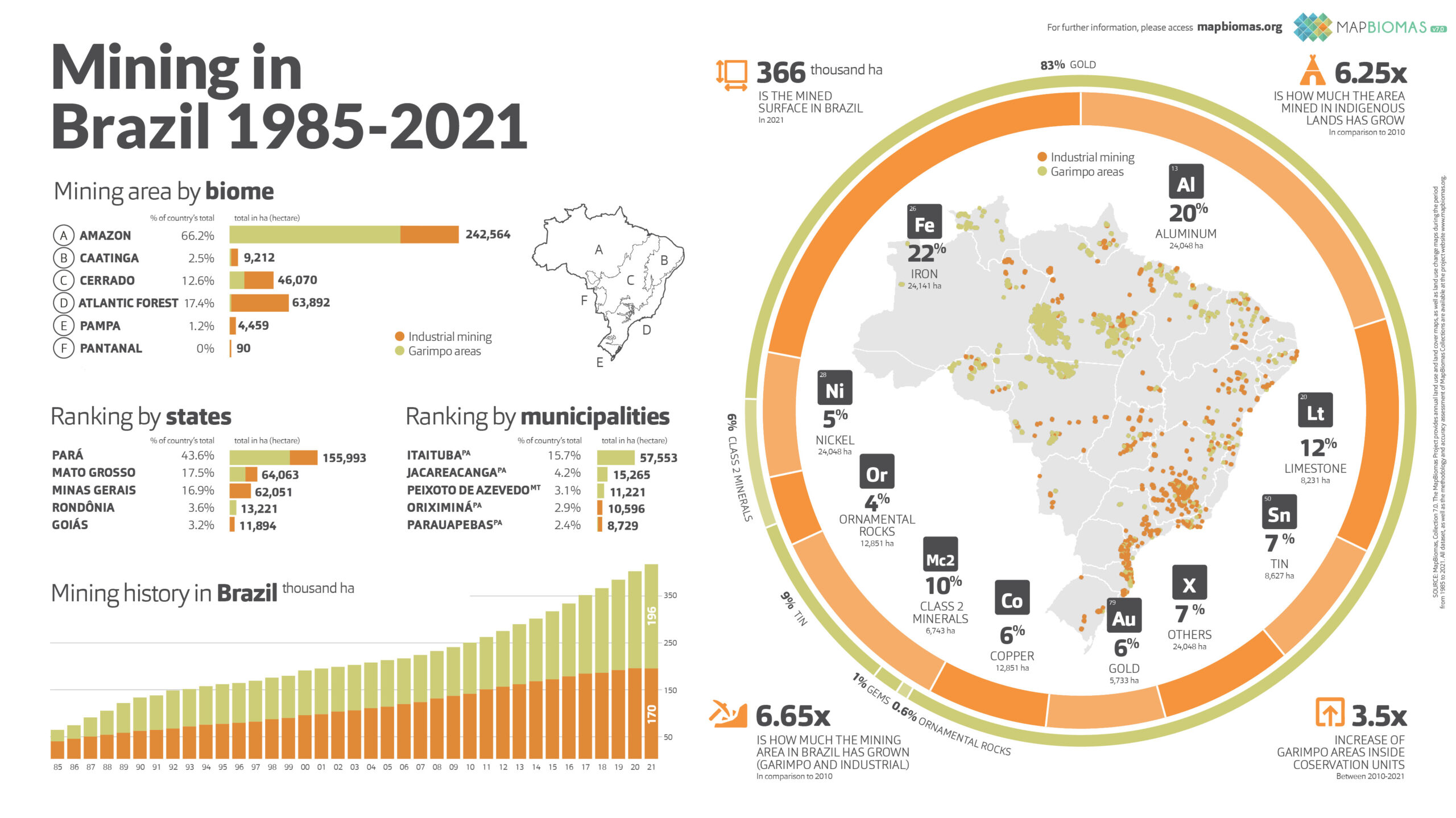Just two states - Pará and Mato Grosso - account for 91.9% of the mining in Brazil. Avanço do garimpo sobre terras indígenas foi de 632% entre 2010 e 2021
Access the Mining Highlights in Collection 7 of MapBiomas Brasil
The area of garimpo in Brazil has doubled in just a decade and has confirmed its tendency to supplant industrial mining. According to the latest data from MapBiomas, which identified the total Brazilian territory occupied by these activities from 1985 until last year, mining went from 99,000 hectares to 196,000 hectares between 2010 and 2021. Industrial mining, on the other hand, took two decades to see the 86,000 hectares occupied in 2001 double to 170,000 hectares in 2021. This is the third consecutive year in which more land is occupied by garimpo than by industrial mining.
This expansion has a clear address - the Amazon Biome. "The historical series shows an uninterrupted growth of garimpo and a sharper pace than industrial mining in the last decade, as well as an unequivocal tendency towards concentration in the Amazon, where 91.6% of the area mined in Brazil in 2021 will be located," explains Cesar Diniz, technical coordinator of the mapping. In the historical series, mining only overtook the area occupied by industrial mining at the end of the last century, between 1989 and 2000.
Two specific states - Pará and Mato Grosso - account for 71.6% of the country's mined areas, i.e. when we add industrial mining and prospecting together. But when mining is considered in isolation, the percentage rises to 91.9%. There are 113,777 hectares of garimpo in Pará and 59,624 hectares in Mato Grosso. Four of the five Brazilian municipalities with the largest garimpo areas are in Pará: Itaituba (57,215 hectares), Jacareacanga (15,265 hectares), São Félix do Xingu (8,126 hectares) and Ourilândia do Norte (7,642 hectares). In third place was Peixoto do Azevedo, in Mato Grosso, with 11,221 hectares.
The expansion of mining in the Amazon has been more intense in protected areas, such as indigenous territories and conservation units. Between 2010 and 2021, mining areas on indigenous lands grew by 632%, occupying almost 20,000 hectares last year. The most exploited indigenous land was Kayapó, where 11,542 hectares were taken up by mining by 2021. This was followed by the Munduruku territory, with 4,743 hectares, the Yanomami land, with 1,556 hectares, the Tenharim do Igarapé Preto, with 1,044 hectares, and the Apyterewa territory, with 172 hectares.
In 2021, the area mined in PAs was 352% larger than the area occupied in 2010. The historical series shows that the area occupied by 2010 was below 20,000 hectares. In 2021, it was almost 60,000 hectares. Of this total, almost two thirds are in the Tapajós APA, where mining already occupies 43,266 hectares. In second place is the Amanã Forest, with 5,400 hectares, followed by the Crepori Forest (1,686 hectares), the Rio Novo National Park (1,637 hectares) and the Jamari Forest (1,191 hectares).
Differences between garimpo and industrial mining
In total, the Amazon concentrated 242,564 hectares of mined area (i.e. adding up garimpo and industrial mining) in 2021. In the case of the Atlantic Forest, this total is 63,892 hectares; in the Cerrado, 46,070 hectares. The Amazon remains the leader when we look at mining alone, with 179,913 hectares. The Cerrado takes second place, with a distant 13,253 hectares; the Atlantic Forest, in turn, concentrates 2,299 hectares.
In the case of industrial mining, the situation is different. There is almost a balance between the area occupied in the Amazon (62,650 hectares) and the Atlantic Forest (61,593 hectares). Another 32,817 hectares are in the Cerrado. The difference lies in Minas Gerais, the state that leads the industrial sector, with almost half (46.9%) of the national total, or 61,181 hectares. The other states with the largest industrial mining areas are Pará (42,216 hectares), Goiás (11,606 hectares), Amazonas (8,166 hectares) and Bahia (7,442 hectares). Together, Minas Gerais and Pará account for 79.2% of Brazil's industrial mining area.
Industrial mining and garimpo also differ in terms of the mineral substances exploited. While industrial mining has a more diversified focus (Fe, Al, Cu, Ni and others), garimpo is concentrated on a few substances (Au and Sn): 83% of the area occupied by garimpo is related to gold extraction and 7% to tin. In the case of industrial mining, 22% of the area is used for iron mining, 20% for aluminum and 12% for limestone.
Follow the webinar that discusses data Mining Collection 7
Download the infographic of the mining data in Brazil of MapBiomas Collection 7


